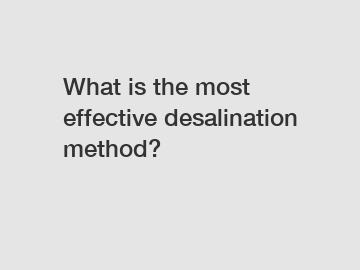Dec. 15, 2023
Environment
What is the most effective desalination method?
Desalination, the process of removing salt and other impurities from seawater to make it suitable for human consumption and irrigation, has emerged as a crucial solution to address the growing global water scarcity. With various desalination methods available, determining the most effective approach becomes critical. Reverse osmosis (RO), a widely practiced desalination technology, is considered the most effective method due to its high efficiency, widespread applicability, and environmental sustainability.
Reverse osmosis utilizes a semi-permeable membrane to separate salt and other minerals from seawater. This process involves applying pressure to seawater, forcing it to pass through the membrane, leaving behind dissolved salts. The purified water collected on the other side of the membrane provides a reliable and safe source of freshwater. .

The effectiveness of reverse osmosis is supported by its efficiency in removing 99% of dissolved salts, producing high-quality water suitable for drinking and agriculture. Compared to other desalination methods, such as thermal distillation, reverse osmosis requires less energy consumption and is more cost-effective. The advancements in membrane technology have also improved the efficiency and lifespan of reverse osmosis systems.
Furthermore, reverse osmosis has a widespread applicability, making it suitable for both large-scale and small-scale desalination projects. It can be easily implemented in coastal regions or remote areas where access to freshwater is limited. The modular design of reverse osmosis plants enables scalability, allowing for adjustments based on water demand.
One of the significant advantages of reverse osmosis is its environmental sustainability. It has a minimal ecological footprint compared to thermal desalination methods, as it does not involve the release of harmful chemicals or the generation of greenhouse gases. Moreover, the brine waste generated from reverse osmosis can be managed effectively to minimize its impact on marine ecosystems.
The use of reverse osmosis in desalination plays a vital role in addressing water scarcity. Its effectiveness in producing freshwater has transformed arid regions into agriculturally productive areas and has secured a reliable water source for rapidly growing populations. Additionally, the implementation of desalination plants powered by renewable energy sources further enhances the sustainability of this method, reducing the dependence on fossil fuels.
In conclusion, the most effective desalination method is reverse osmosis due to its high efficiency, widespread applicability, and environmental sustainability. As water scarcity becomes an increasingly pressing global issue, the continued development and adoption of reverse osmosis technology will contribute to ensuring reliable access to freshwater for various sectors and communities worldwide.
Want more information on Water Control Inflatable Rubber Dam, What is containerized water treatment plant, BIC Containerized Water Treatment Plant? Feel free to contact us.
Previous: How do I choose a HEPA filter?
Next: Which Innovations Can Revolutionize Chemical Fume Capture?
If you are interested in sending in a Guest Blogger Submission,welcome to write for us!
All Comments ( 0 )